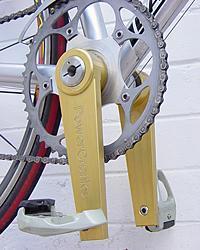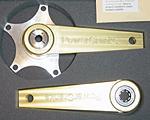
Recently on Cyclingnews.com |
Reviews
PowerCranks: Crank it up
By Ben Larsen
 |
One of the most hotly debated aspects of cycling mechanics is one's pedalling action and the inherent 'dead spots' at the top and bottom of the pedal stroke. Most attempts to overcome the issue to date have been mechanical, and have led to mechanically-minded solutions such as ovalised chainrings (Biopace) and more recently, eccentric crankarms (Rotor).
Rather than changing the mechanics of the bike, PowerCranks looks at changing the mechanics of the rider. Intended as a training tool, PowerCranks are a modified set of cranks that use a clutch bearing in each crank arm to allow only the crank to engage in a forward direction and as a result, the cranks operate independently of one another.
By isolating each leg to prevent the dominant leg from compensating for the weaker one, PowerCranks claim to achieve gains by training the hip flexor muscles to incorporate new muscle mass into their pedalling action, and subconsciously teach your neurologic system to pedal in circles.
How PowerCranks work
The easiest way to get your head around how PowerCranks work is to think about one-legged drills. One-legged drills are usually performed on a stationary trainer by unclipping one leg and resting it on a chair while pedalling with the other leg. The technique isolates one leg from the other and forces the rider to exert even force throughout their pedal stroke. These are quite tough drills and often people struggle with them. Riding PowerCranks is like doing one-legged drills, with both legs, all the time.
The basic principle behind PowerCranks is that by removing the assistance of the downstroke of the opposing pedal stroke you are forced into lifting through the upstroke and pedalling through to achieve any semblance of a normal pedal stroke. By riding PowerCranks regularly, you can train away the weak spots in your pedal stroke and become a more efficient (and faster) cyclist.
Now this all sounds pretty simple right? Apply power through the complete revolution, how hard can it be? The answer is that is not quite that simple, and it can be harder than you think, but the benefits are potentially enormous.
 |
First Looks
PowerCranks are solidly constructed and the bearings and finish are all very high quality. Function and durability are the key words here and they look the goods too. PowerCranks come in several lengths and also an adjustable-length version that will allow you to adjust your crank length over time. I went for 175mm standard version.
Set-up
PowerCranks come in versions capable of being used with a standard square bottom bottom bracket or a Shimano-splined bottom bracket. I had the splined version and found them no more difficult to install than a normal Shimano crank. The only real difference is that you have to be a little more careful to get the splines lined up properly; without the ability to push each crank backwards, the feel is less pronounced. The dust cap/fixing caps also need to be installed to hold the crank on, but this is also a straightforward task for even the least mechanically minded.
The cranks do not come with chainrings, so you will need to install some, but again, this is a simple task in itself. I have changed the cranks back and forth several times in the first three months to revert to normal cranks for races and have not had any problems. Total time to swap cranks is less than 15 minutes after the first time.
Month 1
As per the instructions, I started off on the stationary trainer to get used to them before venturing onto the road. For the first two weeks, my rides were daily 5-10 minute sessions after which I was glad to get off the bike. My biggest initial problems were not so much muscular as they were co-ordination related; I really struggled to keep my legs synchronised, and my left leg kept lagging behind my right or stalling altogether. At times, I was reduced to laughter as my legs simply refused to do my bidding - it is strange and humbling that such a basic and familiar action should prove so difficult after only five minutes.
On the road
 |
After a fortnight, I hadn't got far beyond the 10 minutes mark in any session, so I decided to bite the bullet and just get on the road. I have always struggled with the motivation to ride indoors and I had promised to train exclusively on PowerCranks, so figured if I did not hit the road soon, my weekly training mileage would remain in double digits.
I made all my early rides on a 30km flat and relatively low traffic route to avoid any undue trouble. Normally 30km might be a warm-up or recovery ride but these early sessions were quite challenging. Early troubles on the road include starting from traffic lights and the fact that it is initially impossible to get out of the saddle. Each day's ride brought rapid adaptation, but I would still rate most sessions in the first month as quite hard.
Month 2
After a fortnight on the flatter roads, I started to increase the distance and add hills to my rides. Seated climbing is no big problem and is probably the easiest riding situation on PowerCranks, because even on normal cranks there is a far more even distribution of power. Mastering riding out of the saddle after a month of seated riding is like your first time without training wheels and quite liberating.
The fatigue at this point is still very neuromuscular and finishing a 60-70km training ride feels like a combination of a normal long training ride without the normal fatigue of the big muscle groups (quads and glutes) and a three hour exam. Pedalling continually for long periods is difficult and I still coast regularly for short rest periods on longer rides.
Month 3
Riding is now becoming almost natural and I have started commuting through heavy Sydney traffic without serious concerns, although stopping and starting is still a pain in the butt. Every ride is still a serious workout but not in the sense of being uncomfortable, just that I still have to think at all times. My legs are now well synchronised and I am just getting to the point where I can start to really fatigue my leg muscles. I have got back up to my normal mid-winter mileage of ~200km/week and have started cycle racing.
Report card
Unlike mechanical solutions like the Rotor, PowerCranks are a long-term proposition and the cycling benefits are not immediately available in empirical terms. It is expected that first big gains can take up to six months. After three months of training exclusively on PowerCranks, I can report changes in the following areas:
Synchronisation: Having to synchronise my pedalling has been the most profound change and unexpected challenge with PowerCranks. In my attempt to using both legs in a co-ordinated fashion, I believe my pedalling has significantly improved and my stroke timing is smooth and consistent.
Circular pedalling: This was the expected challenge of PowerCranks but the extent of how much this impacted on my riding was still surprises me. While not yet perfect, my pedalling force is now applied more evenly and the levels of muscle fatigue are well below historical levels for similar efforts.
Balance: I have always had a right leg dominance on the bike. This was quite noticeable at the start, but has become more and more balanced as I have adapted. This imbalance often caused tight glutes on the one side after hard training or racing, yet is something I have not experienced in recent weeks.
As for results on the bike, I resumed road racing in Month 3 and managed two wins from two starts and have now been promoted to A-grade. While the race results are my best in over a year, I would not say that I feel significantly stronger yet as a result of training on PowerCranks, I can certainly say that I am far more conscious my of pedalling - even while I race on normal cranks and that my perceived effort during these races was lower than expected.
As for my performances off the bike (no, not those performances!-Ed), the PowerCranks web site promotes early improvement in running as an additional benefit, so I decided to run the Sydney Morning Herald Half Marathon as a test after 6 weeks. I surprised myself on minimal training with a sub-85 minute race, bettering my 89 minute mark from the year before on the same very hilly course. The synchronisation benefit from using PowerCranks appears to apply to running mechanics as well, and the 'picking up' of your feet meant that my running felt faster and smoother than before.
However, the impact of training on PowerCranks is difficult to evaluate numerically without a testing facility of some sort (sorry, no pro team contract just yet), but I expect the benefits to be more obvious as race distances become longer. Gradual improvements in technique and efficiency are easily blurred by testing variances and training volumes each week, but I am already racing faster than my fitness would suggest and my ability to turn a gear over is improved, so it's a good start.
Conclusion
Whatever your level of pedalling efficiency, it is hard to imagine that these cranks won't make your training sessions more effective. Initial adaptation is challenging and some initial discomfort (especially on your rear end and lower back) from staying seated for longer periods is experiened during those early weeks; however, in a comparatively short period of time, PowerCranks have forced marked changes in my pedalling technique and application of force on each pedal stroke. Follow-on benefits to running and your body's core stability are also a plus.
Recommended retail price: US$690.00
Pro: Improved technique and efficiency
Con: Some tenacity required to get past the initial adaptation, cost
More information: PowerCranks
website
Cyclingnews Rating: ![]()
What do you think of PowerCranks? Let us know

